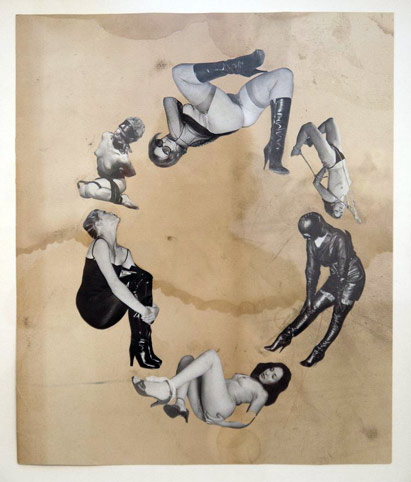I bought a doughnut and they gave me a receipt for the doughnut. I don’t need a receipt for the doughnut.
more { d’Eon & Grimes’s Darkbloom }
more { d’Eon & Grimes’s Darkbloom }
Humpback whales have their own version of the hit single, according to a new study. At any given time within a population, male humpbacks all sing the same mating tune. But the pattern of the song changes over time, with the new and apparently catchy versions of the song spreading repeatedly across the ocean, almost always traveling from west to east. (…)
This is the first time that such broad-scale and population-wide cultural exchange has been documented in any species other than humans, she added.

In the present study 24 university students read four different texts in four conditions:
(1) while listening to music they preferred to listen to while studying;
(2) while listening to music they did not prefer to listen to while studying;
(3) while listening to a recording of noise from a café; and finally
(4) in silence.
After each text they took a reading-comprehension test. Eye movement data were recorded for all participants in all conditions.
A main effect for the reading-comprehension scores revealed that the participants scored significantly lower after they had been listening to the non-preferred music while reading, compared with reading in silence.
photo { Kyoko Hamada }
Language, according to Benveniste, is the only semiotic system capable of interpreting another semiotic system. How, then, does language manage when it has to interpret music? Alas, it seems, very badly. If one looks at the normal practice of music criticism (or, which is often the same thing, of conversations “on” music), it can readily be seen that a work (or its performance) is only ever translated into the poorest of linguistic categories: the adjective. Music, by natural bent, is that which at once receives an adjective.
The adjective is inevitable: this music is this, this execution is that. No doubt the moment we turn an art into a subject (for an article, for a conversation) there is nothing left but to give it predicates; in the case of music, however, such predication unfailingly takes the most facile and trivial form, that of the epithet. Naturally, this epithet, to which we are constantly led by weakness or fascination (little parlour game: talk about a piece of music without using a single adjective), has an economic function: the predicate is always the bulwark with which the subject’s imaginary protects itself from the loss which threatens it. The man who provides himself or is provided with an adjective is now hurt, now pleased, but always constituted.
{ Roland Barthes, The Grain of the Voice, | Continue reading }
Why is it that some of us can’t live without an iPod perpetually connected to our ears while others couldn’t care less about music?
Our love of listening to tunes may be influenced by whether or not we carry a particular gene.
Researchers have discovered that a gene with the snappy name arginine vasopressin receptor 1A (AVPR1A), is found more frequently in people who relish a good toe-tapper. (…)
Studies have also found genetic traits associated with being tone deaf. Other genes have been found to relate to absolute pitch, aka “perfect pitch” (being able to name a certain note just by hearing it).
In late 1979, Debbie Harry suggested that Nile Rodgers join her and Chris Stein at a Hip hop event in a communal space taken over by young kids and teenagers with boom box stereos, who would play various pieces of music to which performers would break dance. The main piece of music they would use was the break section of “Good Times.”
A few weeks later, Blondie, The Clash and Chic were playing a gig in New York at Bonds nightclub. When Chic started playing “Good Times,” rapper Fab Five Freddy and members of the Sugarhill Gang jumped up on stage and started freestyling with the band; Rodgers allowed them to “do their improvisation thing like poets, much like I would play guitar with Prince.”
A few weeks later Rodgers was on the dance floor of New York club LaViticus and suddenly heard the DJ play a song which opened with Edwards bass line from “Good Times”. Rogers approached the DJ who said he was playing a record he had just bought that day in Harlem. The song turned out to be an early version of “Rapper’s Delight” by The Sugarhill Gang, which Rogers noted also included a scratched version of the song’s string section. Rogers and Edwards threatened The Sugarhill Gang with legal action, which resulted in them being credited as co-writers on “Rappers Delight”.
When forming first impressions about individuals, we often categorize them as belonging to a specific social group, based on very little information. Certain aspects in the way a person looks, or information about a certain trait they possess, may lead us to identify them as belonging to a high- or low-status social group. (…)
The idea of a correlation between various traits has been demonstrated in the ‘halo effect’ (Thorndike, 1920), showing the tendency to attribute all-positive or all-negative traits to individuals, based on one positive or negative initial trait. (…)
A variety of variables of physical appearance, such as dress, bodily posture, weight and perceived attractiveness have been shown to have an effect on the impression individuals make. Gender schemas are one of the parameters through which we infer personality traits, and have been demonstrated to have a strong influence on the impression formation. Males are generally perceived as possessing more high-status traits, such as assertiveness and competence, than females. (…)
Listening to music is an activity that plays an important role in people’s lives, especially in adolescence and young adulthood. Individuals consider the music they like as an important part of themselves, and believe their taste in music reveals aspects of their own personality, more than preferences for books, clothing, food, movies and television shows. The idea that personal musical taste is related to other aspects of personality has in fact received further confirmation in various studies relating musical preferences and particular personality traits. Thus, for example, liking for rock, heavy metal and punk were found to be positively related to sensation-seeking; extraversion and psychoticism were found to be related to liking for music with ‘exaggerated bass’ such as rap and dance music, and to stimulating music such as rock-and-roll and pop; rebelliousness was found to be related to liking for defiant music. (…)
Studies suggest that knowing a person’s musical taste has a powerful effect on how they are perceived and evaluated.

Humans experience pleasure from a variety of stimuli, including food, money, and psychoactive drugs. Such pleasures are largely made possible by a brain chemical called dopamine, which activates what is known as the mesolimbic system — a network of interconnected brain regions that mediate reward. Most often, rewarding stimuli are biologically necessary for survival (such as food), can directly stimulate activity of the mesolimbic system (such as some psychoactive drugs), or are tangible items (such as money).
However, humans can experience pleasure from more abstract stimuli, such as art or music, which do not fit into any of these categories. Such stimuli have persisted across countless generations and remain important in daily life today. Interestingly, the experience of pleasure from these abstract stimuli is highly specific to cultural and personal preferences.
collage { Eric Foss }
{ Dan Deacon on NBC morning | Thanks Brad! }
{ www.mta.me turns the New York subway system into an interactive string instrument }
more to watch { Documentary on American composer Milton Babbitt, who died Saturday, Jan. 29 }

Interview with Curt Cobain, January 27, 1994 issue of Rolling Stone
Along with everything else that went wrong onstage tonight, you left without playing “Smells like Teen Spirit.” Why?
That would have been the icing on the cake. That would have made everything twice as worse. I don’t even remember the guitar solo on “Teen Spirit.” It would take me five minutes to sit in the catering room and learn the solo. (…)
Have you ever been that consumed with distress or pain or rage that you actually wanted to kill yourself?
For five years during the time I had my stomach problem, yeah. I wanted to kill myself every day. I came very close many times. I’m sorry to be so blunt about it. It was to the point where I was on tour, lying on the floor, vomiting air because I couldn’t hold down water. And then I had to play a show in 20 minutes. I would sing and cough up blood. This is no way to live a life. I love to play music, but something was not right. So I decided to medicate myself.
photo { Tierney Gearon }
{ Delia Derbyshire - Sculptress of Sound documentary | Episodes 2 to 7 }
related { The Art of Noises by Luigi Russolo, theorist of electronic music. | Scribd | full text }